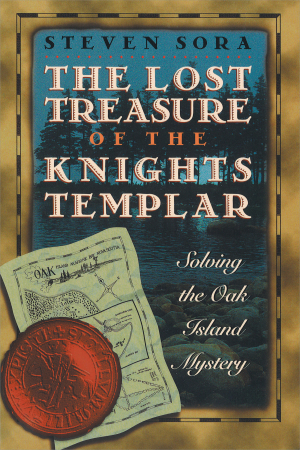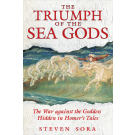- Pages: 304
- Book Size: 6 x 9
- ISBN-13: 9780892817108
- Imprint: Destiny Books
- On Sale Date: February 1, 1999
- Format: Paperback Book
- Illustrations: 6 b&w illustrations
• Fascinating occult detective work linking the Cathars, the Scottish Masons, and Renne-le-Chateau to the elusive treasure pit on Oak Island
• Draws on new evidence recently unearthed in Italy, France, and Scotland to provide a compelling solution to one of the world's most enduring mysteries
When the Order of Knights Templar was ruthlessly dissolved in 1307 by King Philip the Fair of France it possessed immense wealth and political power, yet none of the treasure the Templars amassed has ever been found. Their treasure is rumored to contain artifacts of spiritual significance retrieved by the order during the Crusades, including the genealogies of David and Jesus and documents that trace these bloodlines into the royal bloodlines of Merovingian France.
Placing a Scottish presence in the New World a century before Columbus, Steven Sora paints a credible scenario that the Sinclair clan of Scotland transported the wealth of the Templars--entrusted to them as the Masonic heirs of the order--to a remote island off the shores of present-day Nova Scotia. The mysterious money pit there is commonly believed to have been built before 1497 and has guarded its secret contents tenaciously despite two centuries of determined efforts to unearth it. All of these efforts (one even financed by American president Franklin Delano Roosevelt) have failed, thanks to an elaborate system of booby traps, false beaches, hidden drains, and other hazards of remarkable ingenuity and technological complexity.
The Lost Treasure of the Knights Templar
Solving the Oak Island Mystery
Regardless of their spiritual beliefs, all of the refugees were under a sentence of death. If the Romans caught up with them, every man would be crucified; their women and children sold into life-long slavery. The circumstances of defeat had not only obliterated their kingdom; it had reduced them to First Century "boat-people", forced to risk their lives on dangerous seas, rather than certainly lose them by remaining behind on the land. All too conscious of the fate looming in the north, the Mauretanians and their West African co-workers labored ferociously to finish the new ships. There was another urgent consideration: the weather. Spring was waning, and if the fleet was not ready by mid-summer, it would not be able to sail until the following year, too late to escape the doom intended for them. November was the storm season, and the refugees must arrive at their distant destination before then. Otherwise, the prospect of surviving the prolonged voyage in makeshift vessels was bleak. Urgency gave impetus to their efforts, and the hastily completed ships were boarded a few weeks after the summer solstice.
The priests and holy men representing half-a-dozen or more different faiths pleaded with their own versions of God for His blessing on the desperate adventure. The great vessels, heavily laden with passengers and supplies, lurched out over that vast, rolling carpet of the heaving unknown Roman cynicism disparaged as "the Pasture of Fools". Crowds of West Africans with their uncertain monarch gathered on shore to watch the strange craft carrying their stranger passengers and crews from Mauretania further away toward the west with every foaming plunge. . .
But they had not thrown themselves aimlessly into the Atlantic Ocean just to escape their pursuers. They knew where they were going. Or, at least their navigators did. The sea-faring heritage of Mauretania was already centuries old when King Juba II sent out expeditions to the Canary Islands, even as far as Madeira, in search of murex mollusks for his lucrative purple dye industry. Henceforward, the Classical World referred to these distant shores as the Purpurariae, or "Purple Isles".
Juba's great library contained his Punic legacy of sailing instructions to the whereabouts of distant, prosperous locations unknown to the outside world, but jealously regarded by Carthaginian merchants as treasured commercial secrets. Charts drawn from an abundance of such privileged information enabled the captains of the refugee fleet to find their way to what the Roman cartographers vaguely knew as the Epeiros Occidentalis, conjectured continents that most likely lay in the far west, beyond the horizon only suicidal fools dared to seek. Actually, the existence of, if not sailing instructions to both continents had been known for more than two hundred years before, at least. A globe of the world created by the Greek geographer, Crates of Mallos, and preserved for the Romans in the writings of Strabo, identified North America as Peroikoi; South America was Antipodea. . .
While a July-August passage across the tranquil central Atlantic may have been tedious, it was, outside of an isolated storm or two, mercifully uneventful. The point from which the expedition left Africa would have thrust it directly into the Canary Island Current, which flows westward straight across the Atlantic to the opposite side of the ocean. As their ships approached the Gulf of Mexico, however, they arrived during the hurricane season. Some must have been sunk with loss of life. Others were separated and scattered to the coasts of Florida, Mexico and Panama. . .
The main body of immigrant vessels entered the mouth of the Mississippi River, sailing northward into the North American continent. Such a passage would not be possible today. With construction of "wing-dams" in the late 19th Century, but especially after the installation of locks during the 1930s, the Father of Waters' southward moving current increased to its present seven mile-per-hour flow. . . They undoubtedly pulled into shore from time to time for repairs and other necessities. At such landing intervals, foraging parties hunted game and brought back edible fruits. It was then that the vital presence of so many armed troops who accompanied the expedition was apparent. Various indigenous groups encountered along the way made mostly furtive appearances, keeping their distance from the awesome strangers. Often there were ambushes, surprise assaults. . .
Not all Indian encounters resulted in violence, however. Some tribes showed more of an inclination to barter than fight, and friendly relations with several river peoples were established. Among these the West Africans attracted special notice for their skin color, in the same way unusual or unfamiliar personal traits were regarded as the sure signs of wanaka, or spiritual power. Many blacks jumped ship, preferring to settle where they were wanted, rather than entrusting themselves to the less certain destiny of the white foreigners they served . . . Evidence of their decision to abandon the other refugees survives among a numerically insignificant population of native blacks known today as the Washitaw. They were described as an indigenous people by the renowned explorers, Lewis and Clark, in 1797. . .
While some of their West African deck-hands were jumping ship, the Mauretanians continued to push toward the north in a prolonged expedition that took almost as long as their transatlantic crossing. When they at last reached the Mississippi River's confluence with the Ohio River, autumn was spreading its swirling colors over the Earth. The newcomers were not the first to visit this spectacularly raw wilderness. They had been preceded centuries before by Phoenician path-finders who came in search of the rare goods that once made their Carthaginian capital the richest city in the world. Their detailed exploratory knowledge of the "Opposite Continent", cited as long ago as the 4th Century B.C. by the Greek philosopher, Plato, in his dialogue, the Kritias, was classified information. . .
Steering east into the Ohio River, the refugee fleet cruised around the bottom of what would millennia later become the State of Illinois. . .
Acknowledgments
Introduction
1 The Mystery of Oak Island
2 Theories and Suspects: Who Dug the Money Pit and What Lies Below
3 Prelude to Expedition
4 The Scottish Discovery of America
5 "...If Two of Them are Dead"
6 The Knights Templar of Scotland
7 The Secret of the Templars
8 The French Connection
9 The Mystery of Rennes-le-Chateau
10 The Connecting Thread
11 The Treasure Comes to Oak Island
12 Oak Kings, Severed Heads, and the Secrets of the Ancients
13 The Grail Guardians and the Modern World
Epilogue: The Grail Guardians Treasure and Oak Island
Notes
Bibliography
Index
Mark Stavish, Institute for Hermetic Studies, Feb 2006
"The Lost Treasure of the Knights Templar will have you turning its pages deep into the night, and Steven Sora should be commended for his fascinating, seamless scenario!"
Bodhi Tree Book Review, Winter 1999 / Spring 2000
"If you enjoy a good non-fiction mystery, a kind of arm chair treasure hunt, and are a bit of a closet archaeologist or a medievalist to boot, this is a book for you. Fascinating reading."
Convergence, Volume Thirteen Issue One
“. . . well written and enjoyable. . . . a good summation of the Oak Island mystery.”
Mike Gleason, Witchgrove, March 2007
When the Order of Knights Templar was ruthlessly dissolved by King Philip the Fair of France in 1307, it possessed immense wealth and political power. Yet none of the treasure amassed by the Templars has ever been found. This lost treasure is rumored to have contained artifacts of spiritual significance that were retrieved by the order during the Crusades, including the genealogies of David and Jesus, as well as documents that trace these bloodlines into the royal bloodlines of Merovingian France--documents that were perceived by those in power in medieval Europe as a threat to the established order of church and state.
But what connects this treasure to the Oak Island Money Pit--so-called because of both the priceless treasure it may house and the extraordinary sums of money spent in futile attempts to excavate it--that has baffled treasure hunters for over two hundred years? Using new-found historical evidence that places a Scottish presence in the New World a century before Columbus, Steven Sora presents a fascinating and convincing scenario that has the Sinclair clan of Scotland transporting the wealth of the Templars--entrusted to them as the Masonic heirs of the order--to a remote island off the shores of present-day Nova Scotia. The mysterious money pit there is commonly believed to have been built before 1497 and has guarded its secret tenaciously despite two centuries of determined efforts to unearth it. All of these efforts (one even financed by American president Franklin Delano Roosevelt) have failed, thanks to an elaborate system of booby traps, false beaches, hidden drains, and other hazards of remarkable ingenuity and technological complexity created by its builders. Even in recent years, despite the increasingly sophisticated tools at our disposal, the secret of the Oak Island Money Pit has remained beyond our reach.
At least until now.
STEVEN SORA (1952-2021) had been researching unusual historical enigmas since 1982. The Lost Treasure of the Knights Templar was his first book.
















